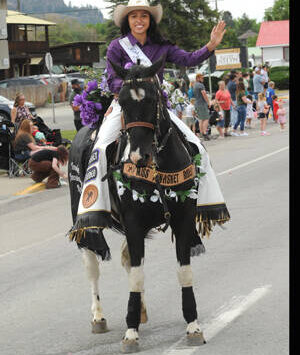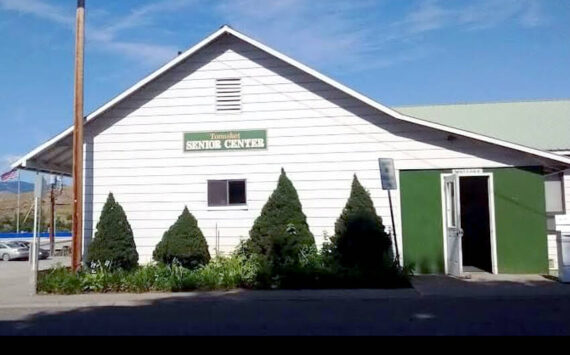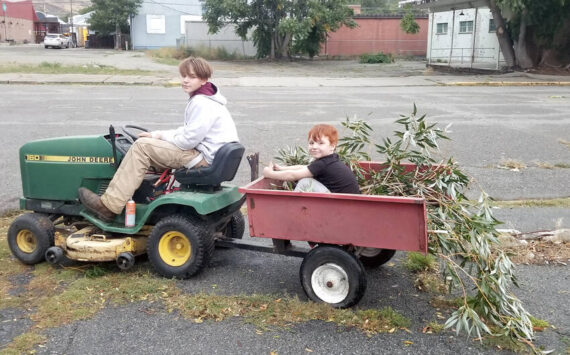TONASKET – Discussion about the future of the Tonasket Municipal Swimming pool continued at the Tuesday, Nov. 12, city council meeting after the council had had a chance to review a book-length report completed by Pool World of Spokane at its behest.
With four options for an outdoor pool costing anywhere from $1.5 million to $2.5 million the council intends to host a town hall meeting (date still to be determined) to invite the public to share its thoughts and try to guage how much material support there will be for the project.
“We’d have all four alternatives posted,” said city planner Kurt Danison of Highlands Associates. “We’ll post the budget for each one, and I’ll spend time going through each one … We’ll have time to answer some questions … Then basically we would get colored dots and let people vote.
“We’ll get some kind of idea of what people want,” he added, saying such a vote would be considered an expression of public opinion as opposed to committing the city to a particular course of action. “We’ll see what level of support the community wants to show. The council needs to make a decision on the direction we’re going to go, or more importantly, if we’re even going to go at all.”
Still to be determined is whether or not the city is willing or able to pursue the project itself, or whether a recreation district for the pool would need to be formed to increase the number of area residents supporting the project.
“This goes back to the issue of a recreation district or just within the city limit who would be burdened,” said council member Jill Vugteveen. “There are people outside the city that we charge a very minimum rate to use the facility. We need to go back and look at drawing a boundary 5-10 miles outside the city limits to make it a pool district.”
Danison pointed out that in a survey taken at the time the decision was made to close the pool, people indicated they were willing to pay a higher entry fee than what was being asked but were not willing to be taxed for a new pool.
“But they do want a new pool,” he said. “Part of the decision is, what can we afford?”
“Even if we get the pool for free,” said council member Scott Olson, “if we can’t afford to run it, we don’t want it.”
Danison said it would cost at least $25,000 per year to open the pool just during the summer months.
“It may not be as grandiose as what people might like to see,” he said. “But needs to be something that we can take care of in the long run.”
Mayor Patrick Plumb said that, in light of the recent failure of the criminal justice tax on the November ballot (which would have added 0.1 percent to the sales tax rate in the city), he wondered if the pool this year would have been able to stay open with current budget constraints.
“It is troubling to me,” he said. “It failed miserably, but we’re still being pressured to offer more services than we can afford. And then, we’re asked not to raise taxes. So we are in a conundrum, especially when there have been choices made by multiple customers of the area… that they are shopping out of town.
“When you don’t shop in town (which sends sales tax dollars out of the community) you can’t afford the luxury of these services available to the public without reducing services. That’s what has happened to our budget cycle this year. Imagine having a pool on top of that this year. What would we have done?
“I still say it failed because people don’t understand where the money comes from and how it can be spent,” said council member Jean Ramsey. “Water/sewer funds cannot just go anywhere. It’s not just one big pot.”
The council did not set a date for its town hall meeting, but it will likely take place in early January at a location other than the council chambers.
Streets and sidewalks
Danison also said that the next day (Nov. 13) he was fulfilling an earlier directive from the council to apply to the Transportation Alternatives Program for a $91,000 grant that would be used to put in a sidewalk that would extend from the corner of 6th and Whitcomb (US-97) to the Bonaparte Creek Bridge. This would provide additional infrastructure to support a proposed foot bridge that would allow pedestrians to cross the creek to the U.S. Armed Forces Legacy Park instead of having to walk along the shoulder of US-97 to do so.
Danison said he would additionally be applying to the Service Transportation Program for a grant for the bridge itself – as well as additional funding for the sidewalk if the TAP grant was denied.
He also brought up the sore subject of the condition of Whitcomb Avenue itself through the downtown business core.
“The crown is higher than some of the doorways to the businesses,” Danison said, citing the flooding that occurred during heavy rains in September. “But any town under 5,000 (population), all DOT (Department of Transportation) will do is chip seal.
“What we decided to do, is that we are seriously going to our legislators and asking them to see if they can get a reconstruction of Whitcomb from Bonaparte to Siwash (creeks), including curbs, sidewalks, ADA ramps, four trees per block, street signs – complete streets from wall to wall
“We’ll go to the state legislators and seeing if we can get a line item in the capital budget. Not the transportation budget. The DOT won’t do it.”
He pointed out that a chip seal would actually raise the elevation of the street, which would further increase the potential for flooding.
“I don’t want to downplay the significance of our downtown core of being in the kind of danger it was,” Plumb said. “Regardless of whether it was a 100-year storm, 500-year, climate change, or whatever.”
Budget hearing
The final hearing for the 2014 budget was held, though city clerk Alice Attwood said she wouldn’t be able to finalize the budget for a number of reasons.
“I still don’t have numbers from the assessor’s office,” she said, adding that without that she can’t factor in how the annexation of the Mill Drive/Bonaparte Creek area (and its associated property taxes) would affect the budget, nor could she calculate the exact amount of the ad valorem tax increase approved last month.
The council also directed her to include a cost of living adjustment for city employees (based on the Consumer Price Index) but opted not to include any extra funds for any meetings over the three per month for which the council gets paid.
Cop car awaits
Police Sgt. Darren Curtis said that the recently-purchased used police car had arrived but would not be able to be put into service until after the first of the year.
“We had to get it in the city’s name,” he said. “But we don’t have the money to have somebody put all the stuff into it.
“It’s a police package car – that means the motor and suspension have been upgraded and that kind of thing. It doesn’t have a light bar, or other things we need for us to utilize it.”
After the first of the year, the department will be able to afford installation costs, as well as a new light bar that will cost around $1,000, he said.
The council also approved Curtis’s request to apply for a grant for up to $10,000 from the Washington State Police Chiefs traffic safety grant program for a variety of equipment for the department.
Attwood added that she would research grants through Rural Development for the purchase of an additional police car without dipping into the city’s general fund.
The city council next meets on Tuesday, Nov. 26.




